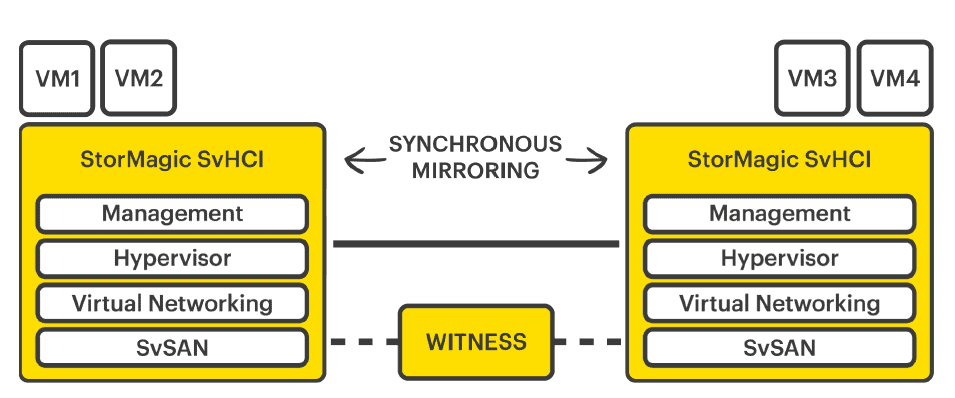StorMagic was founded 18 years ago. Until recently, it dealt primarily with storage virtualization. Earlier this year, however, it also announced and later launched a hyperconverged offering. What kind of company is StorMagic, what does its product portfolio look like and what does the addition of hyperconverged say about its ambitions? You can read all about it in this article.
We attended a presentation by Bruce Kornfeld and Julian Chesterfield, StorMagic’s CPO and CTO, respectively, at the most recent edition of A3 Communications Technology Live. We had certainly heard of the company before, but had not really looked into it. So that just had to change. Because StorMagic is quite an interesting company, if only because they claim to be one of the inventors of vSAN. They brought SvSAN to market before VMware came out with vSAN.
Meanwhile, StorMagic is 18 years old. One of the company’s distinguishing features is its explicit focus on smaller environments. “We don’t focus on the data center,” Kornfeld explicitly states. StorMagic targets markets that require on-site IT, companies that want to run applications on a small site. They define it as enterprise edge and SMB/SME.
Smaller environments demand different things
The fact that StorMagic focuses on smaller environments was a choice, we hear during the session. Of course, everyone says that in retrospect, even though they secretly would have been quite happy to operate in large data centers. In the case of StorMagic, however, it does seem to have been a conscious choice. That is, StorMagic is not trying to fold an enterprise architecture into an edge environment. By default, a cluster consists of two nodes with a so-called silent witness running in the cloud. With this cluster of two nodes, StorMagic guarantees 100 percent uptime. Expansions generally take place with two nodes at a time, although StorMagic can also create clusters with an odd number of nodes upon request.
StorMagic’s offerings (SvSAN, SvHCI) can run on very small servers, something other solutions cannot do, Kornfeld points out. That might suggest that it can also only be deployed in small environments. That’s not the case, according to Kornfeld and Chesterfield. For example, some customers have servers with four processors driving hundreds of terabytes of storage. There is currently a theoretical upper limit of 50 VMs per cluster. In practice, more is certainly possible as well. They just haven’t seen use cases at the edge that have required more.
HPE largest partner, “thank you Broadcom”
StorMagic’s biggest partner at the moment is HPE. While that company has the necessary solutions around storage and HCI in its portfolio, apparently it also need specific partnerships for edge locations. According to Kornfeld and Chesterfield, HPE initially thought Simplivity could be brought down into the market to where StoreVirtual sat. However, that didn’t happen, so then HPE came to StorMagic.
StorMagic is currently seeing a lot of interest in what it has to offer from VMware customers. “Thank you Broadcom for creating the chaos,” in Kornfeld’s words. Basically, anything below VMware’s top 2,000 accounts is no longer of interest to Broadcom. “We see a lot of customers who want to move away from VMware, but bite the bullet for another year,” he says. Those customers are postponing their decision. The long tail of the changes Broadcom has made at VMware is expected to be quite robust. Right now, many customers don’t seem to be making the switch just yet, but that probably will come.
Silent witness is the secret sauce
Basically, SvHCI works identically to how SvSAN worked. That is, again, it involves clusters of two nodes, where there is 100 percent uptime thanks to the silent witness. This silent witness is what Kornfeld calls the secret sauce. It is the third element of StorMagic’s infrastructure, in addition to the two nodes.
The silent witness monitors whether the nodes, and thus the clusters, continue to function properly. For the integrity of the data on the various nodes, it is important that they do not start having a mind of their own if the connection between the two nodes is lost. That is what the silent witness must take care of. This component must provide so-called quorum. You can think of it as an arbiter who has a casting vote in the process. He must ensure that one of the two nodes is the leader. If that cannot be determined, he intervenes.
Since the silent witness is an impartial part of the whole, he cannot be on any of the servers that are part of the clusters. He must be on a separate server, either in the cloud or on-premises. The silent witness can monitor thousands of clusters.
Like the rest of the architecture, the silent witness is made for edge environments. That is, it does not need tremendously low latency to keep working. Anything under 3000ms is fine. This makes it virtually impossible to find a location where the silent witness cannot function. In addition, there are also no huge bandwidth requirements. The silent witness already works with a bandwidth of 9Kb/s. Per second, no more than 100 bytes of data passes over the link between them.
From SvSAN to SvHCI
With an 18-year history in vSAN, it’s safe to say StorMagic knows what it’s talking about when it comes to SvSAN. Earlier this year, however, it came out with a full-stack product. Whereas with SvSAN you can talk about hyperconverged storage, with SvHCI the company came up with a full-stack HCI offering. With SvSAN, customers choose their own hypervisor (vSphere, Hyper-V or Linux KVM), with SvHCI it’s a stack with KVM hypervisor. The base of SvHCI is obviously SvSAN, on top of that is the KVM hypervisor and on top of that again is the management layer.

So SvHCI is a fully integrated HCI stack. That gives customers less flexibility than they have if they only purchase SvSAN from StorMagic. On the other hand, SvHCI is extremely simple to deploy and get up and running. Customers don’t have to think about many things. That is definitely an advantage. Especially in edge environments, there’s a chance that an off-the-shelf system can meet needs just fine. Customers do have a choice of (x86) hardware, by the way. That could be from Dell, HPE, Lenovo or Supermicro. StorMagic does have a compatibility list for this. So it is important to look at it carefully.
Currently, SvHCI is not yet generally available. Orders can be placed starting in the first quarter of 2025.
StorMagic SvHCI promises a lot
StorMagic makes the necessary promises around SvHCI. Besides being built for edge environments and guaranteeing 100 percent uptime combined with 24/7 support, those promises are mainly in the cost department. According to the presenters from StorMagic, this is significantly lower than that of other solutions.
For a full-stack solution with 2 TB of storage, the price is just over $2,000 per node per year. So that means a starting price of just over $4,000 per node per year, since a minimum of two nodes are needed to create a cluster. That, according to StorMagic’s calculations, is already over $1,000 (21 percent) less compared to the same system with two nodes based on VMware vSphere and vSAN. If we scale this math to a five-year subscription with 48 TB, this difference increases very quickly to over $75,000 (62 percent).
Mind you, StorMagic’s offering is not the most feature-rich you can find on the market. Of course, that also explains much of the lower cost. StorMagic talks about “right-sized” or “just right” features and functionality and does promise a complete virtualization platform. It can do that because StorMagic actually developed it for edge locations. That’s not the case if you go for a VMware-based system.
VMware is the biggest competitor to StorMagic, however, also for this product. They claim that they don’t encounter the likes of Scale Computing very often. This seems strange, since that company also focuses primarily on edge locations with complete solutions and on replacing VMware environments. On the other hand, there is a chance that customers will primarily make a comparison between VMware and one of the alternatives that have specific edge offerings rather than between several of those alternatives.
StorMagic commits to SvHCI
Finally, we want to take a moment to reflect on StorMagic’s plans for SvHCI. The company may argue that it is already a complete virtualization platform, but that does not mean that it cannot be further improved. So after the announcement in June of this year, and the availability of SvHCI in August it has been working hard to make this happen. The result of this is that StorMagic announces some updates today. We highlight three of them.
The most important in terms of data protection is the addition of VM Snapshots. With these, you can restore data if necessary, for example in the case of a ransomware attack. Up to 16 snapshots per VM are possible, which are also provided with retention policies. The latter takes place automatically.
A second update is the integration of the Edge Control management layer into the SvSAN and SvHCI offerings. This makes it possible to access all systems from a central location. You can then monitor them, but also manage them to set up system updates, for example. You can manage up to thousands of remote sites with this management layer.
The third and final update today that we would like to highlight has to do with migration from VMware to StorMagic SvHCI. With VM Import, this should become possible. This new functionality will be available in the SvHCI Virtualization Manager. It’s a wizard that lets you connect to the VMware ESXi instances you want to transfer, then choose the host within the SvHCI cluster and then assign the appropriate networks to the imported VMs. After that, the process can begin.
All in all, StorMagic gives SvHCI some interesting updates. All of them are important if they want to compete with VMware in particular. The general mood at customers might help StorMagic as well. That is, a substantial number of VMware customers must be at least thinking about replacing VMware. Many of them no longer play a hugely important role in Broadcom’s vision, so will be receptive to an alternative. If that alternative is also much more attractive in terms of cost, which StorMagic claims to be, they would do well to take a closer look.
The first version of SvHCI (SvHCI 1.2) has been available since August of this year. The latest version (SvHCI 2.0) with the updates above can be ordered starting in the first quarter of 2025.
Reading Tip: AWS means serious business with European Sovereign Cloud: how does it stack up?
